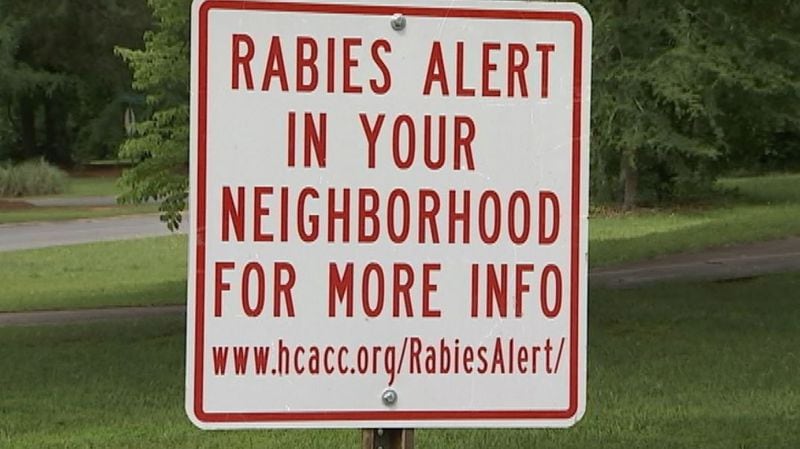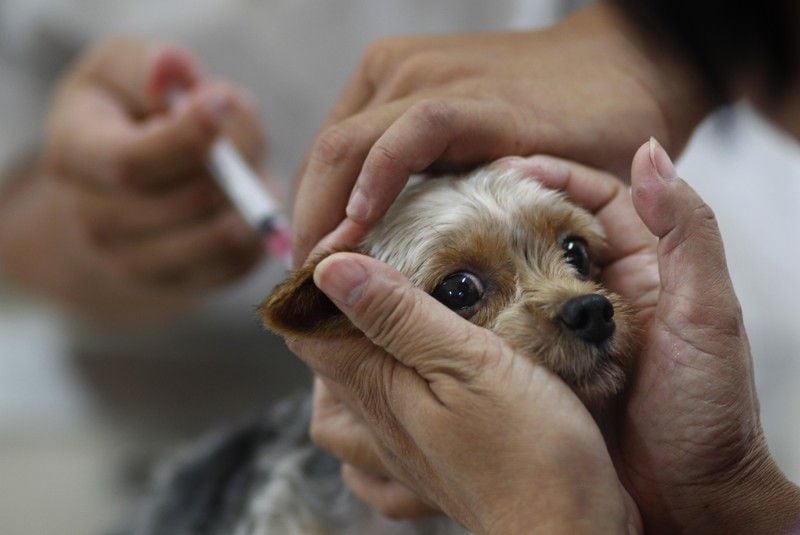You’ve probably heard horror stories about rabid coyotes, dogs and other animals attacking humans, but how much do you really know about the potentially fatal viral infection?
» RELATED: Warm weather brings surge in metro Atlanta’s reported rabies cases
Here are nine things you should know about rabies:
What is rabies?
According to Atlanta-based Centers for Disease Control and Prevention, rabies is "a preventable viral disease of mammals most often transmitted through the bite of a rabid animal."
It is caused by the rabies virus and is regularly found on all continents, except Antarctica.
The virus potentially threatens more than 3 million people in Asia and Africa, the World Health Organization reported.
» RELATED: Free rabies vaccinations available after seventh confirmed bite
Which wild animals are most likely to transmit rabies?
In the U.S., the majority of rabies cases reported to the CDC annually occur in raccoons, skunks, bats and foxes.
But worldwide, the CDC estimates 90 percent of exposures are due to rabid dogs.
What are the signs and symptoms of rabies in humans?
Early signs: fever, headache, weakness or discomfort.
Progressive symptoms: insomnia, anxiety, confusion, slight or partial paralysis, excitation, hallucinations, agitation, hypersalivation, difficulty swallowing and hydrophobia.
» RELATED: Another rabid fox attack reported in Gwinnett
Death usually occurs within days of experiencing the symptoms above.
How many people die annually from the rabies virus?
According to the World Health Organization's 2016 report, the virus claims an estimated 59,000 human lives, mostly in developing countries.
In the U.S., only two to three human deaths due to rabies are reported annually — a major improvement from the previous century, when the number of rabies accounted for more than 100 human deaths each year.
The global epidemic in human fatalities is more difficult to measure due to underreporting in developing countries with inadequate public health resources and limited access to preventive treatment, especially when it comes to animal vaccination, according to the CDC.
» RELATED: Rabid coyote attacks Roswell man just before killing challenge begins
"Despite evidence that control of dog rabies through programs of animal vaccination and elimination of stray dogs can reduce the incidence of human rabies, exposure to rabid dogs is still the cause of over 90% of human exposures to rabies and of over 99% of human deaths worldwide," CDC researchers said.
What do you do if you’re bit by an animal?
The first thing to do is to wash your wounds with soap and water (and iodine, if you’re not allergic) to decrease the chance of infection.
Then, schedule a visit with your doctor to find out if a rabies vaccine is necessary.
Your physician may instead provide other means of treatment if the vaccine is deemed unnecessary.
» RELATED: Three people in Norcross attacked by rabid cat
How does the rabies virus affect the body?
- The virus travels from the site of the bite through nerves to the spinal cord or brain. During this period (which can last for weeks to months), animals don't look sick and bites by these animals don't carry a risk of rabies yet.
- After the virus reaches the brain, it multiplies and causes an inflammation of the brain. At this time, you can see the first signs and symptoms of rabies in the animal.
- The virus moves from the brain to the salivary glands and saliva. Within seven days of becoming ill, the infected animal usually dies.
Some wild animals, such as raccoons, have the virus in their saliva before they even show signs of illness.
The reason for any variation between exposure and onset is due to factors such as type of virus and immunity, researchers said.
How is rabies treated?
Rabies is completely preventable by vaccine, but, as aforementioned, consult with your physician about treatment options.
Those who have never been vaccinated should receive both the human rabies immune globulin (HRIG) and the rabies vaccine, according to CDC researchers.
» RELATED: Terrifying video: Rabid bobcat attacks Florida Fish and Wildlife officer
For people who have been previously vaccinated or for those receiving pre-exposure treatment, the vaccine alone is recommended.
There are few and mild adverse reactions to the vaccine, including some pain, redness, swelling or itching. Even fewer people report headache, muscle aches or dizziness.
What are the signs and symptoms of rabies in dogs?
Uncontrolled rabies in dogs is the largest global source of human rabies cases, according to the CDC. So, it’s important to watch out for any signs and symptoms in your furry friend.
Here's a list of symptoms to look for, according to Pets WebMD:
- behavioral changes (aggression, restlessness, apprehension)
- biting, snapping, attacking other animals, humans or objects
- constantly licking, biting or chewing at bite site
- fever
- hypersensitive to touch, light and sound
- eating unusual things
- hiding in dark places
- paralysis of the throat, jaw muscles
- foaming at the mouth
- loss of appetite
- weakness
- seizures
How can you protect yourself (and your pet) against rabies?
In addition to vaccinating your pets against rabies, you’ll want to make sure they aren’t exposed to too much wildlife.
The CDC also recommends spaying and neutering pets to avoid increasing the number of stray animals.
Avoid approaching wild animals and if you see a stray, injured or dead animal, call your local animal control officer. You should also teach these same precautions to your children.








